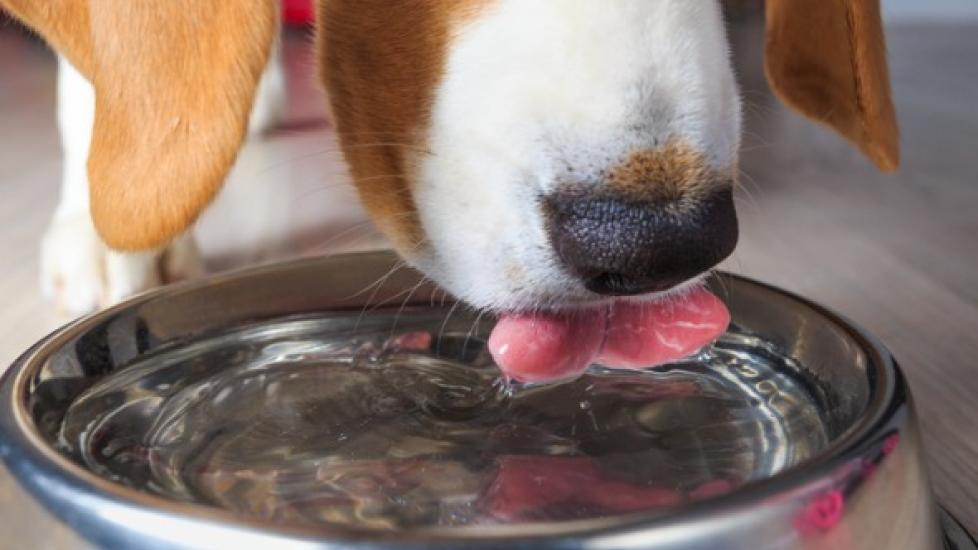How Much Water Should a Dog Drink?
Reviewed and updated for accuracy on August, 11, 2020 by Jennifer Larsen, DVM, PhD, DAVCN
Water is the main component of healthy, living cells of the body. Without water, your dog’s body will not function properly. More specifically, your dog will dehydrate.
This can happen if your dog isn’t getting enough water, which is why you should clean and refill your dog’s water bowl daily.
You also need to be aware of when your dog is drinking more water than usual, as this could be a sign of illness.
So how much water should a dog drink? Find out whether your dog is drinking enough water or more water than usual.
How Much Water Does a Dog Need?
There are several ways to estimate how much water an individual dog needs, and this tend to vary due to individual circumstances.
In general, dogs should drink approximately 1 ounce of water (1/8 of a cup) per pound of body weight each day. However, there are many factors that can affect how much your dog will drink, so you should not be restricting your dog’s water intake.
Unless directed by your veterinarian, it’s not necessary to measure out the exact water amounts your pet drinks. Just make sure that your dog has plenty of fresh, clean water every day.
Why Your Dog Might Drink Less Water Sometimes
Here are a few common reasons why a dog might be drinking less water than usual.
Your Dog Is Eating Wet Food or a Homemade Diet
Dogs that are fed a canned food or a homemade diet will receive some moisture through their food, as these are about 65-80% water. You might notice that your dog drinks less than when eating only dry kibble on a daily basis.
Your Dog May Be Sick or in Pain
If your dog is sick from another underlying cause, or has mobility or pain issues, they also might not drink the amount of water they need. Talk with your veterinarian to figure out why your dog is not drinking enough water and how you can help.
Your Dog Is Hot or Exercising
Depending on the temperature and the amount of exercise your dog does, more water may be necessary. This is because water is lost with excessive panting and salivation.
Can Dogs Drink Tap Water?
Tap water that is safe for people is also safe for dogs. In most cases, tap water is fine for your dog. However, if you live in a place with unsafe tap or well water, please discuss options with your veterinarian for providing bottled or filtered water for your dog.
What Happens if a Dog Doesn’t Get Enough Water?
Many important body functions require water, so without an adequate supply, your dog can become quickly become ill and dehydrated.
Organs will eventually become damaged with sustained water deficiency, and if it lasts long enough, the kidneys, liver, and other organs will begin to shut down. Death will follow shortly after.
In general, a healthy dog will drink enough water daily to stay well hydrated, but there are a few instances where dehydration can occur.
Here are a few situations where a dog may be at increased risk of dehydration:
-
Kidney disease
-
Metabolic disorders (such as diabetes)
-
Cancer
-
Pregnant/nursing animals are at risk of becoming dehydrated more readily, since they may have higher needs
How to Check Your Dog for Dehydration
Follow these steps to see if your dog is dehydrated:
-
Gently pinch the skin between the shoulder blades.
-
Pull the skin up gently and release it.
-
Watch for the skin to fall back into place.
The skin should quickly return to place without any hesitation. If dehydration is present, the skin will slowly return or may even stay up for a time before falling back into place.
Here are some other signs of dehydration in dogs:
-
Gums appear dry, sticky, or pale
-
Dry, sunken eyeballs
-
Dry nose and mouth
What if Your Dog Is Drinking an Excessive Amount of Water?
If you notice your dog drinking or urinating more than usual, let your veterinarian know. There are many causes for this problem, since many disease processes show this symptom.
A thorough physical examination along with blood or urine tests can help direct your veterinarian’s next steps. You might be asked to measure your pet’s water intake; in which case, you may need to separate them from other pets.
You should still provide an excess amount of water, but measure how much you add to the bowl and how much is left at the end of each day, plus any that’s added to your dog’s meals, so you can estimate the total amount of water that your dog drinks in a day.
How Often Should You Clean the Water Bowl?
Water and food bowls should be scrubbed with soap and water daily. Since these bowls are in contact with food and your pet’s saliva, they tend to be good places for bacteria to grow.
Bowls should be smooth and easy to clean, without nooks and crannies or even scratches where bacteria can hide and survive.
If you are concerned that your dog is not getting enough water to maintain their health, or is drinking too much water, talk to your veterinarian for advice. Maintaining proper hydration is too important to your dog’s health to ignore.
Featured Image: iStock.com/alex_ugalek
